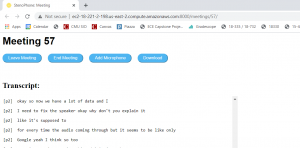Last weekend we finished the migration to AWS so now we are running our server code on the ec2 server, instead of running our server on the local computer.
Since we are now running our system on the server we started on our final standard tests. I completed the 2 tests for the audio device to aws server networking this week .
I first wrote the latency test, this test sends packets to the server and should receive the packet back. I capture the timestamp of the packet when it is sent and compare this to the time stamp of when the packet is received back at the raspberry pi to make sure we use the same clock to calculate the latency. After sending 500 and receiving 500 packets we calculate the average latency of the systems round trip time. We are getting the results of 27-80 ms average latency which is below our requirement of 150 ms latency.
The second test is the dropped packet test, this sends packets to the server for a fixed amount of time and counts the number of packets received back from the server, we calculate the dropped packet rate as (number packets sent – number packets received)/ number packets sent. We ran this test for 2 minutes and 10 minutes and found the dropped packet rate to be less than 1% at .2% and .1% . This also meets our requirement of <5% dropped packets in our system.
These 2 tests are in this ClientTest.py, this file works with the arguments
-b for basic connection to the server test, send and received 1 packet to make sure the connection exists
-l run the full latency test
-d run the full dropped packet test
the tests are in the corresponding functions testLatency and testDroppedPacket
ClientTest
This progress is on schedule we will be testing until next week as well.
Next week I will be working on the final presentation slides and the final report.

